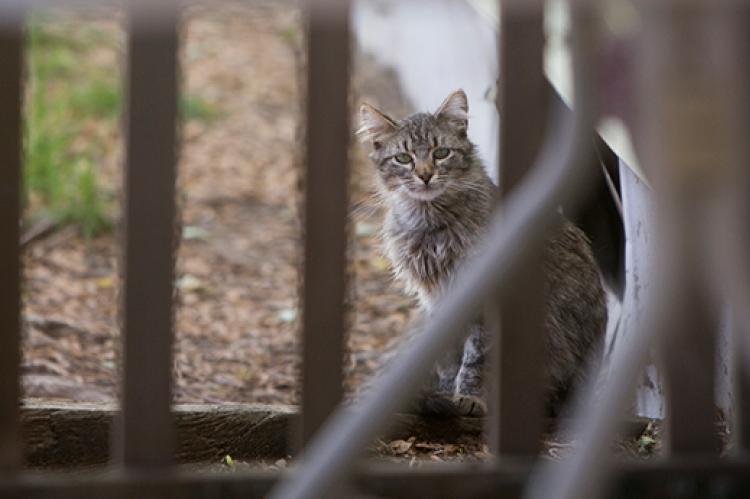How to Find a Lost Cat: Tips From a Pet Detective

The number of missing cats is difficult to estimate, as is the number of cats who tragically are never found. Sometimes pet cats stay lost even though their families do everything they can think of to find them. But many times, people don't know how or where to begin when it comes to how to find a lost cat.
Kat Albrecht, an investigative pet detective, is determined to change that. After all, finding a lost cat is about more than standing outside your front door and yelling, “Here, kitty, kitty.”
How far do cats go when they go missing?
Kat (a former police bloodhound handler, crime scene investigator, and search-and-rescue manager) runs Missing Animal Response Network, which offers courses on basic pet recovery strategies. The courses cover proper search techniques as well as knowing where to search for lost pets. The latter varies depending on the species.
“The behavior of dogs and cats influences the distances they travel,” Kat says. “Dogs run, sometimes great distances, while cats will hide. They not only hide, they do so in silence and typically stay close to home.”
Missing cat hiding inside the house
Sometimes, lost cats are still inside the house. A near-tragic example is the case of Bess, a 2-year-old cat who disappeared one night from her family’s home. Bess remained missing until a few weeks later — when the family suddenly heard a faint “meow” coming from, of all things, a hinged window seat in the living room.
“Bess is a perfect example of why you should comb every inch of your house thoroughly,” Kat says. “Check areas where you think the cat couldn’t possibly be, like inside cupboards, under mattresses, and behind dressers. Check, then check again, because cats may change their hiding spots over time.”
Lost cat hiding outside close to home
Even cats lost outside are consistently found hiding under the porch on their own property or hidden somewhere close by, within just three to five houses of their escape point, Kat says.
Her claim about cats not straying far isn’t just anecdotal. Kat conducted a missing-cat study with Jacquie Rand, a University of Queensland emeritus professor. Using an online questionnaire, they gathered information about 1,210 lost cats to determine which search methods were successful and where cats were most often found.
True to Kat’s experiences, the cats were typically hiding under porches, cars, or other objects near their homes. In fact, 75% of the cats were found within about a third of a mile of their point of escape. And 18% were hiding directly outside an entrance to their home. There was some difference in behavior between cats who live indoors and cats with regular access to the outdoors. Perhaps because they are more at ease outside, 75% of the latter traveled up to almost a mile from home.

How to look for a lost cat
A major finding of the study was the importance of an active physical search: 59% of cats were found alive because their people pounded the pavement and crawled under bushes looking for them. That’s critical because Kat often meets people who rely solely on passive methods, such as posting signs or asking their neighbors to keep an eye out, hoping someone will see their cat and call.
“One of the most common suggestions,” Kat says, “is to put personal items or a dirty litter box outside under the premise that the smell will draw the cat back home.” She doesn’t give that strategy much credence, saying that if the cat does come back on their own, it’s more likely that they overcame the fear of being displaced and returned home. What’s more, Kat says, the pheromones from a litter box can backfire by attracting territorial cats, who then keep the missing cat from returning home.
Kat has also seen the impact that assumptions can have on someone who has lost a pet. Too often, people call off the search prematurely, or don’t look at all, because they believe that their cat has already encountered a coyote or other wild animal.
“Use every possible search method immediately when a cat is lost,” Kat says, “including conducting a thorough physical search, distributing flyers, and putting out humane traps. Go over the same ground multiple times and at multiple times of day.”
And don’t discount the human factor because cats do get picked up and taken to the shelter. They can also assimilate into a nearby group of community cats, so get to know the people in the neighborhood who feed outdoor cats in case they spot a new arrival.

How long do cats usually go missing for?
In the missing-cat study, about 56% of the lost cats were found within two months. But there are plenty of anecdotal and documented cases of people being reunited with their felines months or years after they went astray.
“Above all, don’t give up,” Kat concludes. “Your cat is out there somewhere, waiting to be reunited with the family she loves.”
Top tips for finding a lost cat
The following active approaches will increase the chances of you finding your lost cat. The items on this list are meant to be repeated often.
- Search thoroughly around your property, inside as well as outside. Vary your search times, keeping in mind that cats tend to be most active late at night and early in the morning when it’s quiet.
- Ask neighbors for permission to search their property, and try to expand your search three to five houses in either direction. Make sure to look inside their garages or any other structures where a cat could get trapped.
- Repeat your search and recheck the same spots. Cats can get spooked out of their original hiding spot and find another one in a place that you’ve looked already. If your cat is used to being outside, expand your search.
- Post large eye-catching posters (e.g., use brightly colored paper) with your lost pet information around the immediate neighborhood.
- Post your lost pet information on social media sites like Facebook, Nextdoor, PawBoost, and PetAmberAlert.
- Set humane traps in spots where you can check them frequently; shelters will often rent these traps to the public. You can also use your house or garage as a trap by leaving doors open.
- Check all the shelters that serve your area, not just the one nearest to your home. (Proactively make sure your cat has a microchip or wears a collar and ID tag, so you can be reunited easily if your cat ends up in a shelter.)
For more tips on finding lost pets, go to Missing Animal Response Network.